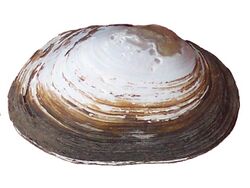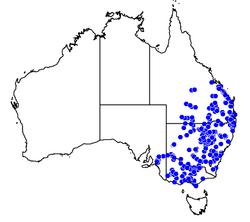Biology:Floodplain mussel
| Floodplain mussel | |
|---|---|

| |
| View of the right valve of Velesunio ambiguus, from Ashley via Moree, Australia. | |
| Scientific classification | |
| Domain: | Eukaryota |
| Kingdom: | Animalia |
| Phylum: | Mollusca |
| Class: | Bivalvia |
| Order: | Unionida |
| Family: | Hyriidae |
| Genus: | Velesunio |
| Species: | V. ambiguus
|
| Binomial name | |
| Velesunio ambiguus (Philippi, 1847)
| |
| Synonyms[1] | |
|
Unio ambiguus Philippi, 1847 | |
Velesunio ambiguus, the floodplain mussel,[2] or the billabong mussel (South Australia),[3] is a species of freshwater bivalve in the family Hyriidae.
There are four other cryptic species in the genus Velesunio (which all look similar to Velesunio ambiguus) in Australia.[4]
Distribution
Australia: Queensland, New South Wales, Victoria,[5] and South Australia, where it is known as the billabong mussel.[3]
Biotope
Static waters.[5]
Life cycle
The lifespan of this mussel is over 20 years.[5]
It can survive temperatures from around 4 °C to over 30 °C.[5]
Human uses
Velesunio ambiguus serves as a food for Australian Aborigines, although its flesh is tough.[5]
This species can also be used in fish ponds to filter microscopic algae out of the water.[5]
References
- ↑ "species Velesunio ambiguus (Philippi, 1847): nominal species". https://mussel-project.uwsp.edu/fmuotwaolcb/validsp_53_syn.html.
- ↑ Wright, D.; Thiem, J.; Blackman, E.; Beatty, S.; Lymbery, A.; Davis, S. (February 2022). Desiccation tolerance of river and floodplain mussels in the Murray-Darling Basin. Report to the Commonwealth Environmental Water Office.. NSW Department of Primary Industries. p. 10. https://www.dcceew.gov.au/sites/default/files/documents/desiccation-tolerance-river-floodplain-mussels-murray-darling-basin.pdf. Retrieved 9 September 2023. ""While neither of the two species widely distributed through the Murray–Darling Basin (MDB) (the river mussel Alathyria jacksoni and the floodplain mussel Velesunio ambiguus) are currently listed as threatened""
- ↑ 3.0 3.1 Wade, Sam; Corbin, Tracey; McDowell, Linda-Marie (June 2004). Critter Catalogue: A guide to the aquatic invertebrates of South Australian inland waters.. Original illustrations by John Bradbury.. Environment Protection Authority (South Australia). p. 28. ISBN 1-876562-67-6. https://www.epa.sa.gov.au/files/8543_critters.pdf. Retrieved 24 November 2020. ""Two species of freshwater mussels (family Hyriidae) occur in South Australia-the river mussel (Alathyria jacksoni) and the billabong mussel (Velesunio ambiguus).""
- ↑ "Conservation of the Australian freshwater mussel". 2006. http://www.benthos.org/database/allnabstracts.cfm/db/Anchorage2006abstracts/id/88.
- ↑ 5.0 5.1 5.2 5.3 5.4 5.5 "Freshwater Mussels - Velesunio ambiguous. Environmental Remediation of Wetlands and Dams". http://www.aquablueseafoods.com.au/other-mussels.shtml.
Wikidata ☰ Q7918897 entry
 |



